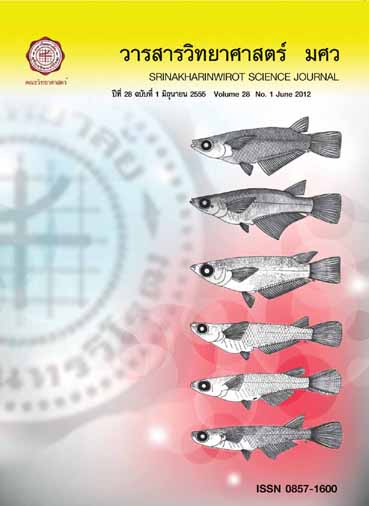การสกัดระดับจุลภาคด้วยวัฏภาคของเหลวโดยใช้เมมเบรนชนิดเส้นใยกลวง เพื่อวิเคราะห์ปริมาณสารกลุ่มพอลิไซคลิกอะโรมาติกไฮโดรคาร์บอนในตัวอย่างน้ำชา (Hollow Fiber Membrane Liquid-Phase Microextraction for Determination of Polycyclic Aromatic Hydrocarbons in Tea Samp
Keywords:
PAHs พอลิพรอพิลีนเมมเบรน แก๊สโครมาโทกราฟี-แมสสเปกโทรเมทรี, PAHs, polypropylene membrane, gas chromatrography-mass spectrometryAbstract
งานวิจัยนี้ได้พัฒนาวิธีการวิเคราะห์สารพอลิไซคลิกอะโรมาติกไฮโดรคาร์บอน (PAHs) 9 ชนิดในน้ำชาโดยใช้การสกัดระดับจุลภาคด้วยวัฏภาคของเหลวและใช้เมมเบรนชนิดเส้นใยกลวงเป็นตัวพยุง แล้วนำไปวิเคราะห์ด้วยเครื่องแก๊สโครมาโทกราฟี-แมสสเปกโทรเมทรี โดยเมมเบรนชนิดเส้นใยกลวงที่ใช้ทำจากพอลิพรอพิลีนที่มีรูพรุน ภายในบรรจุตัวทำละลายอินทรีย์ 25 ไมโครลิตร ในการสกัดสารละลายตัวอย่าง 15 มิลลิลิตร จากการศึกษาสภาวะที่เหมาะสมพบว่า ออกเทนเป็นตัวทำละลายที่เหมาะสมในการสกัดด้วยเมมเบรนชนิดเส้นใยกลวงนี้ โดยใช้อัตราเร็วในการปั่นกวนที่ 700 รอบต่อนาที เป็นเวลา 20 นาที สามารถวิเคราะห์ปริมาณ PAHs ทั้ง 9 ชนิด ได้ขีดจำกัดการตรวจวัดในระดับนาโนกรัมต่อลิตร ค่าสัมประสิทธิ์ของกราฟมาตรฐาน (coefficient of determination, R2) อยู่ในช่วง 0.9852-1 ค่าเบี่ยงเบนมาตรฐานสัมพัทธ์น้อยกว่า 15 เปอร์เซ็นต์ เมื่อนำวิธีสกัดนี้มาหาค่าร้อยละการได้กลับคืนของPAHs ทั้ง 9 ชนิดในตัวอย่างน้ำชา พบว่าอยู่ในช่วง 25-100 เปอร์เซ็นต์ จึงได้ใช้วิธีสแตนดาร์ดแอดดิชันในการวิเคราะห์หาปริมาณสารพอลิไซคลิก อะโรมาติกไฮโดรคาร์บอนในตัวอย่างน้ำชา 11 ตัวอย่าง พบว่ามีปริมาณของ PAHs อยู่ในช่วงความเข้มข้น 5.0-199.8 นาโนกรัมต่อลิตร ซึ่งเป็นปริมาณที่ปลอดภัยตามมาตรฐาน USEPA ข้อดีของวิธีการสกัดนี้คือ ใช้ปริมาณตัวทำละลายอินทรีย์น้อยในระดับไมโครลิตร จัดเป็นเคมีสะอาด (Green Chemistry) เป็นการเตรียมตัวอย่างที่ง่าย รวดเร็ว สามารถสกัดและเพิ่มความเข้มข้นได้ในขั้นตอนเดียว อุปกรณ์ไม่สลับซับซ้อนและราคาไม่สูง The determination of nine polycyclic aromatic hydrocarbons (PAHs) in tea samples has been developed using hollow fiber membrane liquid-phase microextraction and detected by gas chromatography with mass spectrometer. PAHs were extracted from 15 mL of aqueous samples through the immobilized organic solvent in the pores of polypropylene hollow fiber membrane and finally into 25 mL of the same organic solvent. The optimum conditions were studied and found that octane was a good extraction solvent at the stirring rate of 700 rpm for 20 min. The detection limit of this method can be achieved at nanograms per litre level. The calibration curves with the coefficient of determination (R2) in the range of 0.9852-1 were obtained. The relative standard deviations were below 15% and recoveries were in the range of 25-100%. Thus, a standard addition method has been applied to determine 9 PAHs in 11 tea samples. The determined PAHs in all tea samples were in a range of 5.0-199.8 nanograms per litre. All tea samples contained safe levels of PAH when compared to USEPA criteria. The advantage of using micro-litre volume of organic solvent for extraction leads to the extremely low consumption of toxic solvents. The method can thus be considered as a green chemistry initiative. In addition, the extraction and pre-concentration process are combined into a single step. Thus, the technique requires minimal sample preparation time.Downloads
Download data is not yet available.
Downloads
Published
2012-06-20
How to Cite
ทองภูสวรรค์ ว., & ตั้งเตรียมจิตมั่น น. (2012). การสกัดระดับจุลภาคด้วยวัฏภาคของเหลวโดยใช้เมมเบรนชนิดเส้นใยกลวง เพื่อวิเคราะห์ปริมาณสารกลุ่มพอลิไซคลิกอะโรมาติกไฮโดรคาร์บอนในตัวอย่างน้ำชา (Hollow Fiber Membrane Liquid-Phase Microextraction for Determination of Polycyclic Aromatic Hydrocarbons in Tea Samp. Science Essence Journal, 28(1). Retrieved from https://ejournals.swu.ac.th/index.php/sej/article/view/2221
Issue
Section
Research Article








